New Findings from tombs of Chu Aristocrats at Shangcai
Following the discovery of Chu tombs at Yichuan, Henan Province once again sees new, unusual findings of Chu tombs that belong to aristocrats. The site is located at Guozhuang Village, Daluli Town, Shangcai County, three kilometers west of the city site of the Cai State. Up to this moment, a set of valuable cultural relics, including five circle-shaped ding vessels, two mirrors with dragon-shaped ears, and bells as well as qing bells, have been excavated from this site. These findings indicate that the tomb occupant of the major tomb might be a high-ranking aristocrat enfeoffed to the Cai by the Chu State. They provide important material evidence for studying the history and culture of the period from the late Spring and Autumn to the early Warring States.
High-ranking tomb structure and valuable buried objects
Up to this point of excavation, two tombs have been excavated. The two tombs are adjacent, both facing east. The tomb located at the south is the major tomb. It is a large-scale tomb filled in with stone and sand. Its tomb chamber measures 25 meters from east to west, 17 meters from south to north, and 18 meters in depth. The tomb’s structure is peculiar to the extent that its four chamber walls are nearly straight only with one stair-shaped passageway at each of the four corners. The tomb at the north is also a large-scale pit-shaped tomb. It is hypothesized that the tombs were built for a couple.
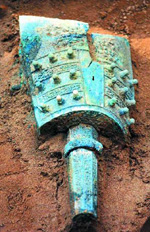
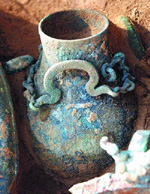
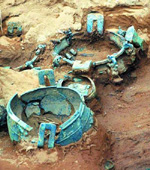
Although only half of the major tomb has been excavated, a quite amount of cultural relics have already been found. These include circle-shaped ding vessels, mirrors with four dragon-shaped ears, square hu vessels, li vessels, dun vessels, yufou basins, musical instrument with bells, capital decorative objects, as well as weapons such as ge (daggers), mao (spears), and zu (arrows). Bronze objects such as horse riding gears have also been found. As well, a certain amount of gilt copper fragments, jade shells, sea shells, and shells made of bone are discovered. Some of these objects may be categorized as precious ritual objects. The largest among them, the circle-shaped ding vessels, has a caliber of 80 centimeters. In terms of volume, it is next only to the largest ding vessel, the huo ding vessel found in the tomb of King You of the Chu at Shouxian County (Anhui). The caliber of the two dragon-eared mirrors measures 67 centimeters, also relatively large in size. The decoration pattern on the two square hu vessels is extremely delicate. In addition, the quality of the two qing stone bells is very high. The inner walls of the outer coffin was originally painted with red patterns against black background and decorated with patterns consisting of gilt copper chips, sea shells, and jade shells. These buried objects from the tomb, which is dated to the early Warring States, should not belong to ordinary aristocrats but must have belonged to a high-ranking aristocrat enfeoffed at Cai by the Chu State.
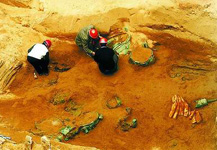

A rare case of tomb filled in with stone and sand
An equally notable aspect of the tomb is its unusual formal character: it is one of the rare cases that may demonstrate the way how ‘tombs filled with stone and sand’ were constructed, a method adopted by ancient people to preempt the possible tomb robbing. In its 18-meter-deep pit, 10 meters are filled with fine sand mixed with thousands of stone with varied sizes and qualities. Not only the heaviest stone weighs more than 150 kilograms but the smallest also weighs a few kilograms. The distance between the bottom of the tomb passageway and that of outer coffin is 5 meters. The sand and stone above and around the outer coffin will instantly bury those tomb raiders once they break into the tomb. From this, we can imagine the great effort that the builders put into the tomb construction. The efficacy of this method can be attested by the fact that despite the 12 incidents of tomb robbing from the Han period onward, the tomb still remains nearly intact.
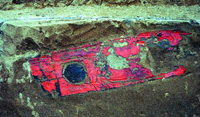
Historical significance
The Cai State was one of the important feudal states during the Western Zhou dynasty. For 500 years, the city site of the Cai State in today’s Shangcai County, functioned as the state’s capital due to its strategic significance. Later, the Chu State merged the Cai, thus beginning its enfeoffemnt of important ministers in this area. It has been hypothesized that the tomb occupant might be one of these enfeoffed aristocrats by the Chu. Naturally, only future decoding of the bronze inscriptions can make clear whether he was a county administrator or an enfeoffed lord.
In spite of his concrete identity, nevertheless, the discovery of the tomb will certainly enrich our understanding on the relations between the Chu and Cai during the late Spring and Autumn and early Warring States period, an aspect that is scarcely touched upon in received literature. Meanwhile, since the Cai as a state possessed both cultural heritage from the Central Plain and the rich Chu culture introduced by the occupiers, this archaeological find will also provide significant materials for studying the cultural assimilations between the two states.
The archaeological works is now being continued at the site.

